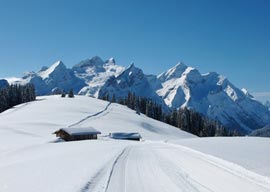
February 14, 2015

Source: Shutterstock
Gstaad—Once upon a time, clergymen saw mountain peaks as natural steeples leading them ever closer to God. Doctors considered the mountains the best medicine for tuberculosis, while explorers saw them as rocks never before touched by humans. I thought of those good people while T-barring up the Eggli, in way below freezing conditions but in bright sunshine. For some strange reason, whenever I’m really cold, I try to think of the German 6th Army trapped in Stalingrad, numbed in body and mind by the cold, while Hitler sits toasty warm back home and orders them to fight to the death. After that, skiing in subzero weather is easy.
Nowadays most skiers wear helmets and ski masks, but at 78 years of age I refuse to look ridiculously like a boy racer, and to hell with safety. The mother of my children ditto. Where did the present craze with helmets originate? From helmet adverts that tell us how easy it is to get brain damage if one crashes on hard snow. Mind you, brain damage in Gstaad is caused mainly by indoor snow, as most people here après-ski.
Last week was as good as it gets: the slopes empty, the snow perfect, the sun shining. But it was very, very cold. Snowcapped mountains are a magnificent sight, and when one thinks that an arrowhead of the Bronze Age was discovered here by some American tourists not so long ago, one sees Hannibal crossing the Alps as a recent visitor. The greatest mountaineer alive is the Swiss, Ueli Steck, a 38-year-old who has scaled the Eiger’s north face solo in 2:47:33, the equivalent of running a marathon in 60 minutes. He is called the “Swiss Machine” by those in the know, and he goes up mountains alpine style, without fixed ropes or oxygen.
I have never met him, although I know someone who accomplishes similar feats of daring, a local Gstaad man by the name of Kobe, pronounced Kubby. He, too, has gone up the Eiger’s north face, a treacherous, almost 90-degree slope of limestone and ice. It’s a funny thing, courage. Kobe and I used to train in karate together, and he’d flinch when I attacked jodan style, to the face. Yet he’d go up like a mountain goat, armed only with crampons and ice axe in places I couldn’t watch on film, such would be the vertigo.
Courage, incidentally, is what one loses with age. Until three or four years ago I could still ski quite fast, but no longer. One begins with fearing a fall, and the next thing you know one is slowly going down a steep slope, like an old lady crossing a busy street. Young schussboomers whizz by, evoking anger at their arrogance, and at one’s cowardice to schuss behind them and pass them. Maybe in the next life. Eight people died in an avalanche last week in France, and signs are posted all over not to go off piste. So what did my son do? He went with Lara Livanos on a helicopter and skied all day with her and a guide in deep powder and way off piste, while her husband and I sat drinking at the Eagle Club in the sun.
Afterward the four of us skied quite fast on piste, without helmets and being rowdy, John Taki leading the group to take nonstop turns finishing with a schuss. The Wasserngrat used to be Papa Hemingway’s favorite mountain, except that he’d go up with skins, drink his wine and eat his prepared lunch, then ski down once and for all. It would take him two hours to go up, and about 30 minutes to descend. We now go up in less than 10 minutes by chairlift, and boom down in about the same time. I’ll take Papa’s days.